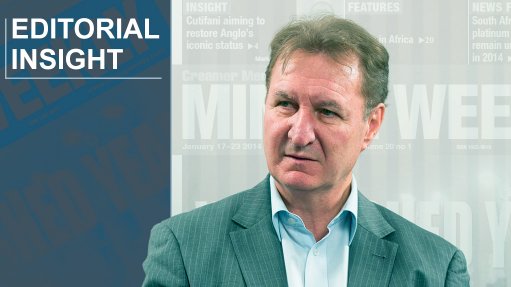
A concerted effort is needed to turn the Congo-Cameroon-Gabon region, often likened to Australia’s iron-ore-rich Pilbara, to positive account.
In March last year, Mining Weekly quoted Investec Securities analysts Hunter Hillcoat and Marc Elliott as saying that this promising area needed a champion to catalyse infrastructure, lower the high sovereign risks, exacerbated by multiple borders, and deal with the demanding operating conditions, assorted ownerships and generally lower ore quality relative to other product available on the seaborne market.
The analysts foresaw the a need for companies, governments, financiers and end-users in a region to collaborate, given the signi- ficant expanse of iron-ore mineralisation, including the potential for meaningful direct shipping ore (DSO) volumes.
Slowly, there is growing involvement, not only from small companies, but also big ones.
The London-, Hong Kong- and now also Johannesburg-listed Glencore, headed by South African-born Ivan Glasenberg, is popping up with greater intensity, along with JSE-listed and black-controlled Exxaro Resources, headed by Sipho Nkosi.
Last Friday, Glencore, with Zanaga Iron Ore Company, awarded the study of the process plant for the next phase of the Zanaga iron-ore project, in the Republic of Congo (RoC), to South African engineering and project management company DRA, and Exxaro’s Nkosi promised at this month’s presentation of financial results that his company would soon have an announcement on the company’s Mayoko project, in the RoC.
Although Glencore does not produce any iron-ore directly, it markets iron-ore sourced from various operations globally, which totalled 19.8-million tons in 2012, up from 10.3-million tons in 2011.
The ‘each company for itself’ approach of Rio Tinto and BHP Billiton when it came to Pilbara infrastructure is seen as how not to do it in this new iron-ore belt.
Instead, a staged, collaborative approach could provide the platform to stimulate important infrastructural decisions.
The latest award to DRA was made by MPD Congo, owned jointly by Glencore and the Zanaga.
This award arises against the background of Glencore’s identification of the potential for a staged approach to the project.
While previous studies had focussed on the viability of a large-scale 30-million-ton-a-year mine, DRA said that the first stage would now involve a far smaller 12-million-ton-a-year operation, linked to the shipping of one- to two-million tons of DSO a year through existing infrastructure.
The area is said to offer one of the few opportunities globally for a substantial iron-ore production base outside the control of the current big three – Vale, Rio Tinto and BHP Billiton.
The downside is that it is still a long way from production but the upside is that those involved currently have strong African links and African hearts.
The development, like all on the continent, must be made to float all boats in order to make both the continent and the world a better place.